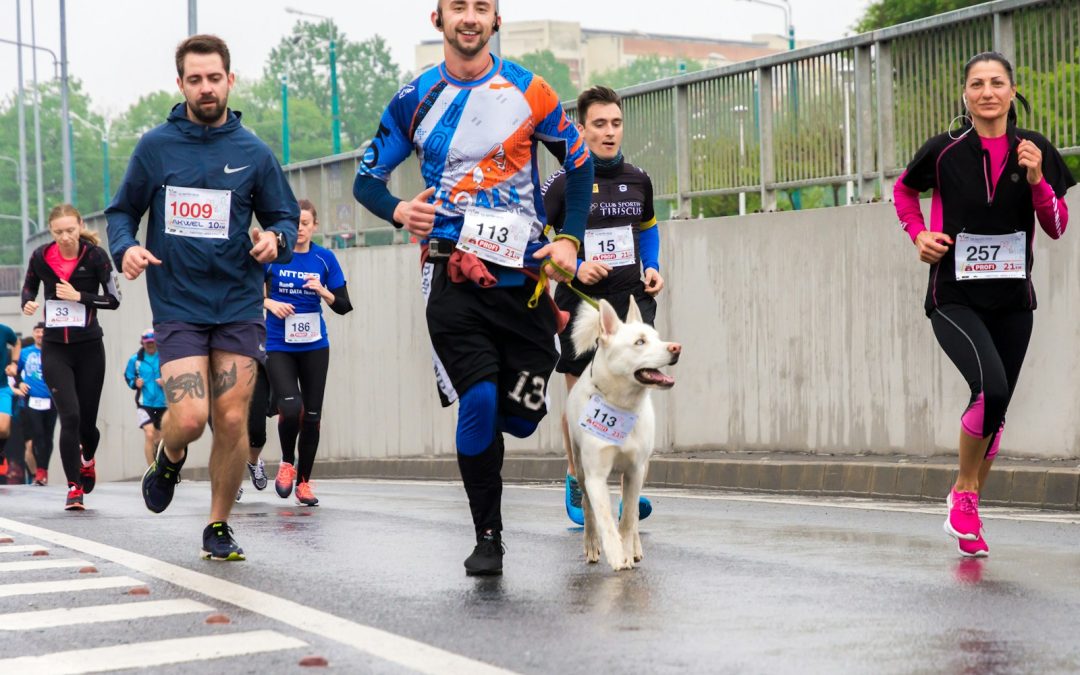MARATHON TRAINING: 5 steps to Marathon success!
With the Manchester Marathon taking place on 14th April and the London Marathon on 21st April, this blog will discuss the importance of training in preparation for such eventS.
Proper training is crucial for participating in a marathon, especially for renowned events like the Manchester & London Marathons. Training prepares the body and mind for the physical and mental demands of running 26.2 miles. It helps build endurance, strength, and stamina, reducing the risk of injuries and improving overall performance.
Preparation & ProActivity
A well-structured training program allows participants to gradually increase their mileage, improve their running technique, and develop the necessary cardiovascular fitness. It also includes cross-training exercises, rest days, and recovery periods to prevent overuse injuries and promote muscle repair.
Training for such established events like the London Marathon requires specific considerations. The course is challenging, with various terrains and elevation changes. Therefore, incorporating hill training and practicing on similar surfaces can better prepare runners for the race.
Additionally, understanding the event’s logistics, such as the start time, route, and aid stations, is essential. Familiarising oneself with the course through training runs or studying maps can help participants strategise and pace themselves effectively during the race.
Lastly, mental preparation is vital. Long-distance running can be physically and mentally demanding. Developing mental resilience, setting realistic goals, and visualising success can contribute to a positive mindset on race day.
STEP 1: TRAINING PROGRAM
A comprehensive marathon training program offers numerous benefits for participants. It not only prepares the body for the physical demands of running a marathon but also helps improve performance, reduce the risk of injuries, and enhance overall endurance. Let’s explore the key phases of a comprehensive marathon training program:
Base Building:
This phase focuses on gradually increasing mileage and building a solid foundation of aerobic fitness. It typically involves running at an easy pace for longer distances, allowing the body to adapt to the demands of running.
LONG RUNS:
Long runs are a crucial component of marathon training. These runs gradually increase in distance, simulating the endurance required for the race. They help build cardiovascular fitness, improve running economy, and mentally prepare participants for the marathon distance.

SPEED WORK:
Speed work involves incorporating interval training, tempo runs, and fartlek workouts into the training program. These workouts improve running speed, enhance lactate threshold, and increase overall race pace. Speed work helps participants develop the ability to sustain a faster pace for longer periods during the marathon.

TAPERING:
Tapering is the phase where training volume decreases, allowing the body to recover and peak for the race. It typically occurs in the final weeks leading up to the marathon. Tapering helps reduce fatigue, repair muscle damage, and optimize performance on race day
RECOVERY:
Recovery is an essential aspect of any training program. It involves rest days, easy runs, and active recovery techniques such as stretching, foam rolling, proper nutrition and sports massages. Adequate recovery allows the body to adapt to the training stress, reduce the risk of overuse injuries, and maintain overall well-being.
STEP 2: Setting Realistic Goals
Setting realistic and achievable goals for marathons are crucial for a successful and fulfilling experience. Several factors, including current fitness level, previous running experience, and personal aspirations, should be considered when determining these goals.
Firstly, considering one’s current fitness level is essential. It is important to assess one’s overall physical condition, including cardiovascular fitness, strength, and endurance. Setting goals that align with one’s current capabilities helps prevent overexertion and reduces the risk of injuries during training and the race itself.
Previous running experience also plays a significant role in goal setting. Those with more experience may have a better understanding of their capabilities and can set more ambitious goals. On the other hand, beginners or individuals with limited running experience may need to set more conservative goals to ensure a positive and manageable experience.
Personal aspirations are another factor to consider. Each individual may have different motivations and desired outcomes for participating in either the Manchester or London Marathon. Some may aim to achieve a personal best time, while others may prioritise completing the race or raising awareness for a cause. Setting goals that align with personal aspirations helps maintain motivation and provides a sense of purpose throughout the training and race.

It is important to strike a balance between setting challenging goals and ensuring they are achievable. Unrealistic goals can lead to disappointment and frustration, while overly conservative goals may not provide enough motivation or a sense of accomplishment.
Consulting with a running coach or experienced runners can be beneficial in setting appropriate goals based on individual circumstances. They can provide guidance on training plans, pacing strategies, and goal-setting techniques.
STEP 3: REST & RECOVERY
Rest and recovery play a significant role in a marathon training plan, as they are essential for preventing burnout and injuries. Adequate rest allows the body to repair and adapt to the physical stress of training, leading to improved performance and reduced risk of overuse injuries.

Sleep is a crucial component of rest and recovery. During sleep, the body undergoes important processes such as muscle repair, hormone regulation, and memory consolidation. Sufficient sleep duration and quality are vital for optimal physical and cognitive functioning. Aim for 7-9 hours of sleep per night to support marathon training.
Active recovery is another important aspect of rest. Engaging in low-intensity activities like gentle stretching, yoga, or light cross-training exercises can promote blood flow, reduce muscle soreness, and enhance recovery. Active recovery helps flush out metabolic waste products and promotes the healing process.
Rest days are equally important in a marathon training plan. These are designated days without any structured training, allowing the body to fully recover and recharge. Rest days give muscles, tendons, and ligaments time to repair and rebuild, reducing the risk of overuse injuries. It is crucial to listen to your body and respect the rest days in your training schedule.
Neglecting rest and recovery can lead to burnout, decreased performance, and increased susceptibility to injuries. Overtraining syndrome, characterized by persistent fatigue, decreased motivation, and increased injury risk, can occur when the body is not given enough time to recover adequately.
STEP 4: INJURY PREVENTION
Remember, everyone’s body is different, so it’s important to listen to your own needs and adjust your training accordingly. By following these tips and seeking professional help when needed, you can minimise the risk of common running injuries and have a successful marathon training experience.
WARM-UP & COOL-DOWN:
Prior to running, perform a dynamic warm-up routine to activate your muscles and increase blood flow. After running, cool down with static stretches to improve flexibility and reduce muscle sorenes
PROPER FOOTWEAR:
Invest in a pair of running shoes that provide adequate support and cushioning for your feet. Visit a specialty running store to get fitted properly and choose shoes that suit your running style and foot type.

Strength EXERCISES & Cross-Training:
These play a vital role in preventing injuries and enhancing overall performance for marathon training. Incorporating these activities into a training program helps build muscular strength, improves stability, and addresses muscle imbalances, reducing the risk of overuse injuries.
- Strength EXERCISES
Strength exercises that target key muscle groups used in running can be beneficial for example, improving gastronemius and soleus strength through calf raises or training glutes, hamstrings, quads and hip flexors through triple extension exercises like squats and lunges.
- CROSS-TRAINING
Cross-training activities complement running by providing variety, reducing the risk of overuse injuries, and improving overall fitness. This may include cycling, swimming, yoga or pilates.
STEP 5: POSt-RACE RECOVERY
After completing a marathon, proper recovery strategies are essential to allow your body to heal and regain strength. Here are some guidance on post-race recovery, including tips on nutrition, active recovery, and gradually returning to running:

Nutrition:
Focus on replenishing your body with nutritious foods. Consume a balanced diet rich in carbohydrates, protein, and healthy fats. Carbohydrates help replenish glycogen stores, while protein aids in muscle repair. Hydrate adequately by drinking plenty of water and electrolyte-rich fluids.
ACTIVE RECOVERY:
Engage in low-impact activities to promote blood flow and aid in muscle recovery. Light walking, swimming, or cycling can help flush out metabolic waste and reduce muscle soreness. Gentle stretching and foam rolling can also alleviate muscle tightness.
REST & SLEEP:
Allow yourself ample rest and prioritise quality sleep. Rest is crucial for tissue repair and overall recovery. Aim for 7-9 hours of uninterrupted sleep each night.
SEEK HELP & ADVICE:
If you experience persistent pain or have concerns about your recovery, consult a healthcare professional or a sports therapist. They can provide personalised advice and guidance based on your specific needs.
If you wish to seek further help or speak to a practitioner about any of the above, call us on 0800 731 2738 or book online here.
You can also view all the services we provide within our clinics on our website, as well as checking out our other blogs and content.
For more free tips and information, make sure to follow our Facebook and Instagram pages. We also post client stories, so you can see how we’ve helped people get back to doing the things they enjoy!



